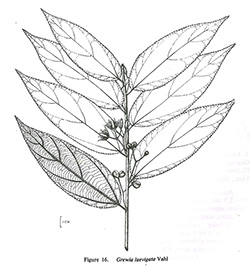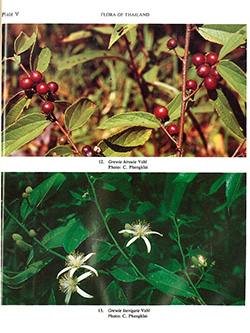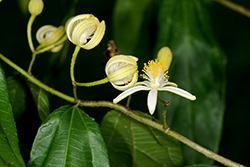e-Flora of Thailand
Volume 6 > Part 1 > Year 1993 > Page 26 > Tiliaceae > Grewia
8. Grewia laevigata Vahlwfo-0000710028
Symb. Bot. 1: 34. 1791; Wight et Arn., Prod. 1: 77. 1834; Mast. in Fl. Br. lnd. 1: 389. 1874; Pierre, Fl. For. Cochinch. 10: t. 161. 1885; Gagnep. in Fl. Gén. I.-C. 1: 539. 1911; Burret, Notizbl. Bot. Gart. Berlin 9: 700. 1926. Fig. 16; Plate V: 13.
Accepted Name : This is currently accepted.
Synonyms & Citations :
Description : Shrub to small tree, up to 10 m high. Leaves oblong-lanceolate, 7–15 by 2.5–5 cm; glabrous or glabrescent; apex cuspidate-acuminate or acute, base obtuse and equal or slightly unequal-sided; margin serrate to serrulate; 3-nerved at base; secondary nerves 4–6 pairs, arched; scalariform veins distinct on lower surface; petioles 5–10 mm long, glabrescent. Inflorescence axillary, very slender and loose or erect 1.5–4 cm long; flower buds oblong, always swollen near base, 4–13 by 2–5 mm. Sepals linear-lanceolate, 10–20 by 1.5–3 mm. Petals oblong, 3–7 by 1.5 mm, glabrous except near base on both surfaces, ciliate along margin. Stamens glabrous. Ovary globose or ovoid, ± 4 by 2 mm, hairy, Fruit rounded , 2–4-lobed, black and woody or dull green and leathery.
Thailand : NORTHERN: Chiang Mai, Mae Hong Son, Phrae, Kamphaeng Phet; NORTH-EASTERN: Loei, Phetchabun; EASTERN: Nakhon Ratchasima; CENTRAL: Saraburi; SOUTH-EASTERN: Chanthaburi, Prachin Buri; SOUTH-WESTERN: Kanchanaburi, Prachuap Khiri Khan; PENINSULAR: throughout.
Distribution : India (type), Nepal, Burma, Vietnam, Malay Peninsula, Indonesia, the Philippines, Australia, Africa.
Ecology : In mixed deciduous and evergreen forests, 10–1,500 m alt. Flowering and fruiting: July–December.
Vernacular : Yap khi kai (ยาบขี้ไก่), po kan tang (ปอกานต่าง), po khi kai (ปอขี้ไก่)(Northern); po khi khoi (ปอขี้ขอย)(Northeastern); po lai (ปอลาย)(Eastern); po hu (ปอหู)(Southeastern); parot nam (ปรอดน้ำ)(Southwestern); som ling (ส้มลิง), phaya dap hak (พญาดาบหัก), yan lueat (ย่านเลือด), mak phlu takkataen (หมากพลูตั๊กแตน), namlai khwai (น้ำลายควาย)(Peninsular).
Uses: Bark produces good fibres for making ropes. Fruits edible.



